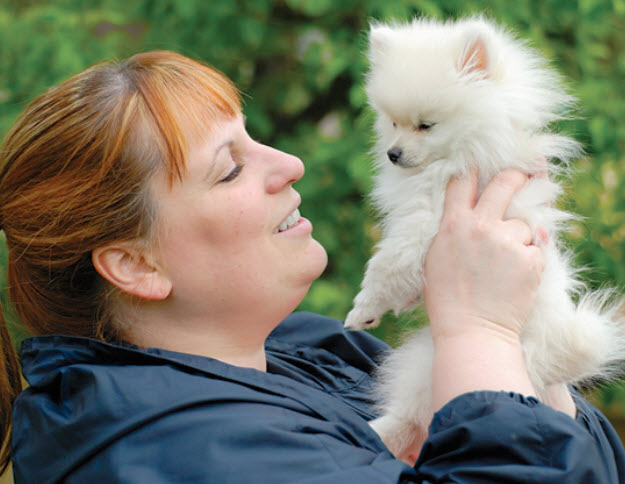Cheer for Pom Poms!
Pomeranians are just full of fluffy personality. Chances are that you chose her because you like Pom Poms and you expected her to have certain traits that would fit your lifestyle:
- Highly intelligent, playful, and energetic
- Outgoing and friendly
- Alert, curious, and busy
- Protective of family—a good watchdog
- Highly trainable and eager to please
- Sweet, gentle, and sensitive
Be prepared for your Pom to have other characteristics:
- May have a tendency to bark excessively
- Can be possessive of toys and food; tends to show dominance
- Prone to boredom and separation anxiety when left alone and will find trouble
- Can be difficult to housetrain
- Fragile and easily injured due to small size
- Can be snappy with children

She's full of personality, and you love her for it! She is a loving and docile companion, but she can be independent and willful. With early socialization and consistent leadership, she is a lively and loyal addition to any family.
The Pomeranian originated in Germany during the 16th century as a large Spitz breed used for sheep herding. They were then bred down in size for companionship. Pomeranians became popular pets when Queen Victoria imported them to Britain in the late 19th century and established a breeding kennel. Poms enjoy close human companionship and bond quickly, but do not tend to be overly clingy. They demand to be the center of attention and enjoy entertaining others with their comical tricks and vivacious outlook on life. The Pomeranian is a generally healthy breed with an average lifespan of 15 years.
Your Pomeranian's Health
We know that because you care so much about your dog, you want to take good care of her. That is why we have summarized the health concerns we will be discussing with you over the life of your Pom. By knowing about health concerns specific to Pomeranians, we can tailor a preventive health plan to watch for and hopefully prevent some predictable risks.
Many diseases and health conditions are genetic, meaning they are related to your pet’s breed. There is a general consensus among canine genetic researchers and veterinary practitioners that the conditions we’ve described herein have a significant rate of incidence and/or impact in this breed. That does not mean your dog will have these problems; it just means that she is more at risk than other dogs. We will describe the most common issues seen in Pomeranians to give you an idea of what may come up in her future. Of course, we can’t cover every possibility here, so always check with us if you notice any unusual signs or symptoms.
This guide contains general health information important to all canines as well as the most important genetic predispositions for Pomeranians. This information helps you and us together plan for your pet’s unique medical needs. At the end of the article, we have also included a description of what you can do at home to keep your Pom Pom looking and feeling her best. You will know what to watch for, and we will all feel better knowing that we’re taking the best possible care of your pal.
General Health Information for your Pomeranian
Dental Disease
Dental disease is the most common chronic problem in pets, affecting 80% of all dogs by age two. Unfortunately, your Pomeranian is more likely than other dogs to have problems with her teeth. Dental disease starts with tartar build-up on the teeth and progresses to infection of the gums and roots of the teeth. If we don’t prevent or treat dental disease, your buddy may lose her teeth and be in danger of damage to her kidneys, liver, heart, and joints. In fact, your Pom's life span may even be cut short by one to three years! We’ll clean your dog’s teeth regularly and let you know what you can do at home to keep those pearly whites clean.
Infections
Pomeranians are susceptible to bacterial and viral infections — the same ones that all dogs can get — such as parvo, rabies, and distemper. Many of these infections are preventable through vaccination, which we will recommend based on her age, the diseases we see in our area, and other factors.
Obesity
Obesity can be a significant health problem in Pomeranians. It is a serious disease that may cause or worsen joint problems, metabolic and digestive disorders, back pain, and heart disease. Though it’s tempting to give your pal food when she looks at you with those soulful eyes, you can “love her to death” with leftover people food and doggie treats. Instead, give her a hug, brush her fur or teeth, play a game with her, or perhaps take her for a walk. She’ll feel better, and so will you!
Parasites
All kinds of worms and bugs can invade your Pom Pom's body, inside and out. Everything from fleas and ticks to ear mites can infest her skin and ears. Hookworms, roundworms, heartworms, and whipworms can get into her system in a number of ways: drinking unclean water, walking on contaminated soil, or being bitten by an infected mosquito. Some of these parasites can be transmitted to you or a family member and are a serious concern for everyone. For your canine friend, these parasites can cause pain, discomfort, and even death, so it’s important that we test for them on a regular basis. We’ll also recommend preventive medication as necessary to keep her healthy.
Spay or Neuter
One of the best things you can do for your Pom is to have her spayed (neutered for males). In females, this means we surgically remove the ovaries and usually the uterus, and in males, it means we surgically remove the testicles. Spaying or neutering decreases the likelihood of certain types of cancers and eliminates the possibility of your pet becoming pregnant or fathering unwanted puppies. Performing this surgery also gives us a chance, while your pet is under anesthesia, to identify and address some of the diseases your dog is likely to develop. For example, if your pet needs hip X-rays or a puppy tooth extracted, this would be a good time—it’s more convenient for you and easier on your friend too. Routine blood testing prior to surgery also helps us to identify and take precautions against common problems that increase anesthetic or surgical risk. Don’t worry; we’ll discuss the specific problems we will be looking for when the time arrives.
Genetic Predispositions for Pomeranians
Heart Disease
Pomeranians are prone to multiple types of heart disease, which can occur both early and later in life. We’ll listen for heart murmurs and abnormal heart rhythms when we examine your pet. When indicated, we’ll perform an annual heart health check, which may include X-rays, an ECG, or an echocardiogram, depending on your dog’s risk factors. Early detection of heart disease often allows us to treat with medication that can prolong your pet’s life for many years. Veterinary dental care and weight control also go a long way in preventing heart disease.
- Poms are susceptible to a condition called patent ductus arteriosus, or PDA, in which a small vessel that carries blood between two parts of the heart does not close as it should shortly after birth. This results in too much blood being carried to the lungs, causing fluid build-up and strain on the heart. Outward signs may be mild or severe, including coughing, fatigue during exercise, weight loss, shortness of breath, and weakness in the hind limbs. We listen for a specific type of heart murmur to diagnose this problem during your pet’s examinations. If your pal has this condition, your Veterinary Village team may recommend surgery to close the problematic vessel.
- Heart failure is a leading cause of death among Pomeranians in their golden years. Most heart disease in dogs is caused by the weakening or slow deformity of heart valves such that they no longer close tightly; blood then leaks back around these weakened valves, straining the heart. Pets with heart valve disease (sometimes called mitral valve disease) have a heart murmur. If your dog has a heart murmur or outward signs suggesting heart problems, we’ll perform testing to determine the severity of the disease. The same tests will need to be repeated at least every year to monitor the condition. If heart valve disease is diagnosed early, we may be able to prescribe medications that could prolong your pet’s life for many years. Veterinary dental care and fatty acid supplementation can also help prevent heart disease, and weight control can help diminish symptoms.
- Sick sinus syndrome is a condition in which the sinus node, the part of the body’s electrical system that signals the heart to beat, doesn’t function properly. If your Pom has this condition, he will have a very low heart rate and may faint with exercise. Mild cases can be treated with medication though if his symptoms are more severe, more advanced care may be needed. We’ll perform an ECG test of the electrical activity of his heart each year and before he undergoes anesthesia to provide the best care for your friend.
Eye Problems
Not many things have as dramatic an impact on your dog's quality of life as the proper functioning of his eyes. Unfortunately, Pomeranians can inherit or develop a number of different eye conditions, some of which may cause blindness if not treated right away, and most of which can be extremely painful! We will evaluate his eyes at every examination to look for any signs for concern.
- Cataracts are a common cause of blindness in older Poms. We’ll watch for the lenses of his eyes to become more opaque—meaning they look cloudy instead of clear—when we examine him. Many dogs adjust well to losing their vision and get along just fine. Surgery to remove cataracts and restore sight may also be an option.
- Entropion is a condition in which the eyelid rolls inward, causing the eyelashes to rub against the cornea (the surface of the eyeball). This is an extremely irritating and painful condition that can ultimately lead to blindness. Entropion can occur in any dog breed, however, your Pom is especially at risk for this heritable disorder. Surgical correction is usually successful if performed early.
- Distichiasis is a condition caused by extra hairs that grow inside of the eyelid and rub on the surface of the eye. This is one of the most commonly inherited diseases in dogs, and your Pom is more likely than other dogs to develop this painful condition. If untreated, these abnormal hairs can cause corneal ulcers and chronic eye pain. Several treatment options are available, and the prognosis is good once the hairs have been permanently removed.
Bone and Joint Problems
A number of different musculoskeletal problems have been reported in Pomeranians. While it may seem overwhelming, each condition can be diagnosed and treated to prevent undue pain and suffering. With diligent observation at home and knowledge about the diseases that may affect your friend's bones, joints, or muscles, you will be able to take great care of him throughout his life.
- Intervertebral disc disease (IVDD) is a common condition in Poms. The disease is caused when the jelly-like cushion between one or more vertebrae slips or ruptures, causing the disc to press on the spinal cord. If your dog is suddenly unable or unwilling to jump or go up stairs, is reluctant to move around, has a hunched back, cries out, or refuses to eat or go potty, he is likely in severe pain. He may even experience sudden paralysis—he may drag his back feet or be unable to get up or use his back legs. If you see these symptoms, don’t wait! Call us at (920) 269-4072 or call an emergency clinic immediately! In many cases involving paralysis, we’ll recommend surgical removal of the ruptured discs (within 24 hours of the onset of symptoms for the best results). For less severe cases, rest and medication may resolve the problem. And as with so many other diseases, weight control helps reduce the risk of IVDD. You should also provide ramps or steps for your pet from puppyhood on to prevent your dog from stressing his back by jumping on and off of the furniture.
- Sometimes your Pom's kneecap (patella) may slip out of place. This is called patellar luxation. You might notice that your pet, while running, suddenly picks up a back leg or skips and hops for a few strides. He might then kick his leg out sideways to pop the kneecap back in place. These are common signs of patellar luxation. If the problem is mild and involves only one leg, your friend may not require much treatment beyond arthritis medication. When symptoms are severe, surgery may be needed to realign the kneecap to keep it from luxating further.
Spinal Cord Injuries
Pomeranians are more likely than other breeds to have instability in the first two neck vertebrae (called the atlantal and axial vertebrae). This condition can cause sudden spinal-cord injuries in the neck. If your dog is suddenly unable or unwilling to jump or go up stairs, if he cries for no apparent reason, or if he tries to turn or lower his head when you pick him up, he may be in severe pain, and you should call us immediately! We’ll control the pain with medication, although surgery may also be recommended. As with so many other diseases, weight control helps to prevent injuries from this condition. With this breed, it’s also important to set up ramps or steps in your home from the time your pet is a puppy to save him a lifetime of stressing his neck when jumping on and off the furniture.
Bladder Stones
If your Pom has an inherited condition called hyperuricosuria, or HU, his urine will contain more uric acid than normal. Uric acid acts like fertilizer for bladder and kidney stone development. A DNA test is available to test for the specific genetic mutation associated with the disease; however, once stones are present, they often must be surgically removed. By testing early, we can identify whether HU is a health risk for your pet—if indicated, we will recommend appropriate dietary therapy to prevent potential problems. Without a DNA test, frequent urine analysis, x-rays, and ultrasound can check to make sure he doesn’t have any painful stones.
Granulomatous Meningoencephalitis (GME)
GME is an acute, progressive inflammatory disease that affects the central nervous system. It can cause severe and often irreversible damage to the brain. Middle-aged, small breed dogs such as Pomeranians are more susceptible than other breeds. The cause of GME is unknown, but three distinct syndromes of GME have been recognized. Symptoms may be acute, leading rapidly to death; they may progress chronically over several months; or occasionally, only the eyes are affected. Treatment includes corticosteroids, but the response to therapy is variable and the prognosis is generally poor.
Water on the Brain
Hydrocephalus occurs when fluid builds up inside the skull, putting pressure on the brain. This condition is most common in breeds with dome-shaped heads, like your Pomeranian. Hydrocephalus most often occurs when the skull bones don’t fuse properly after birth. Signs of hydrocephalus include seizures, dulled mental function, circling, and a spastic gait. Owners of affected pets report that training is also more difficult. Hydrocephalus is usually diagnosed early in life, but is occasionally diagnosed in adult dogs as well. We’ll keep this risk in mind during your pet’s visits, recommend early testing for the condition, and discuss effective treatment options if symptoms develop.
Tracheal Collapse
The trachea, or windpipe, is made up of rings of cartilage that look similar to the ridged hose of a vacuum cleaner. This ridged structure provides both flexibility and strength to the trachea. In Poms, these cartilage rings are sometimes weak or incorrectly formed. As a result, the trachea can collapse and become too narrow, leading to coughing or difficulty breathing. Most cases of tracheal collapse are mild and can be treated symptomatically with medication. When symptoms are severe, however, surgery may be recommended.
Dental Abnormalities
Teeth abnormalities are often genetically induced and are relatively common in dogs, especially in purebred dogs like your Pom. An overbite or underbite is called a malocclusion or a bad bite. Oligodontia is a condition in which only a few teeth are present. Misaligned teeth can also occur and cause lots of problems, but can usually be corrected with braces or extractions. (Yes, dogs can get braces!) We want to keep your buddy’s teeth healthy, so we will be watching his developing teeth closely.
Skin Conditions
Poms are prone to a variety of skin problems, including sebaceous adenitis. You may notice that your dog has dry, scaly skin with patches of hair loss along the top of his head, back of the neck, and along his back. This condition typically develops when your dog is between one and five years of age. Treatment is generally long term, and we’ll likely try a combination of approaches to determine which is most effective with your dog. The response to treatment is highly variable, but you’ll almost always need to give fatty acid supplements and use special shampoos to remove dead skin and hair. The earlier the skin is checked out, the better the results.
Alopecia X
Alopecia X, or adrenal sex-hormone imbalance, is known to causes patchy hair loss. It can also cause a fuzzy or woolly coat appearance on the sides of your friend’s body. Neutering often resolves this condition, or it can sometimes be treated with the same medications used for Cushing’s disease, another disorder involving the adrenal glands. Alopecia X is more of a cosmetic problem than a serious medical issue, but responsible Pom breeders recommend not using affected individuals for breeding.
Thyroid Problems
Poms are prone to a common condition called hypothyroidism in which the body doesn’t make enough thyroid hormone. Signs can include dry skin and coat, hair loss, susceptibility to other skin diseases, weight gain, fearfulness, aggression, and other behavioral changes. We’ll conduct a blood test annually to screen for this disease. Treatment is usually as simple as replacement hormones given in the form of a pill.
Taking Care of Your Pomeranian at Home

Much of what you can do to keep your dog happy and healthy is common sense, just like it is for people. Watch her diet, make sure she gets plenty of exercise, regularly brush her teeth and coat, and call us or a pet emergency hospital when something seems unusual (see “What to Watch For” below). Be sure to adhere to the schedule of examinations and vaccinations that we recommend for her. This is when we’ll give her the necessary “check-ups” and test for diseases and conditions that are common in Poms. Another very important step in caring for your pet is signing up for pet health insurance. There will certainly be medical tests and procedures she will need throughout her life and pet health insurance will help you cover those costs.
Routine Care, Diet, and Exercise
Build her routine care into your schedule to help your Pom Pom live longer, stay healthier, and be happier during her lifetime. We cannot overemphasize the importance of a proper diet and exercise routine.
- Supervise your pet as you would a toddler. Keep doors closed, pick up after yourself, and block off rooms as necessary. This will keep her out of trouble and away from objects she shouldn’t put in her mouth.
- Regular brushing and grooming is needed to keep her coat beautiful.
- Pomeranians often have serious problems with their teeth, so you’ll need to brush them at least three times a week!
- Clean her ears weekly, even as a puppy. Don’t worry—we’ll show you how!
- She is well suited to apartment life as long as she is given daily walks and frequent play sessions.
- She is highly intelligent and can be taught to perform a variety of tricks to help keep her mentally stimulated.
- Due to her assertive nature and small size, she is not recommended for homes with small children.
- Keep your dog’s diet consistent and don’t give her people food.
- Feed a high-quality diet appropriate for her age.
- Exercise your dog regularly, but don’t overdo it at first.
What to Watch For
Any abnormal symptom could be a sign of serious disease or it could just be a minor or temporary problem. The important thing is to be able to tell when to seek veterinary help and how urgently. Many diseases cause dogs to have a characteristic combination of symptoms, which together can be a clear signal that your Pomeranian needs help.
Office Calls
Give us a call for an appointment if you notice any of these types of signs:
- Change in appetite or water consumption
- Tartar build-up, bad breath, red gums, or broken teeth
- Itchy skin (scratching, chewing, or licking); hair loss
- Lethargy, mental dullness, or excessive sleeping
- Fearfulness, aggression, or other behavioral changes
- Dull coat, hair loss; sluggish, weight gain
Emergencies
Seek medical care immediately if you notice any of these types of signs:
- Scratching or shaking the head, tender ears, or ear discharge
- Inability or straining to urinate; discolored urine
- Cloudiness, redness, itching, or any other abnormality involving the eyes
- Coughing, exercise intolerance, rapid breathing at rest
- Unwilling to jump, cries when moving head
- Seizures, dull demeanor, spastic gait
- Leg stiffness; reluctance to rise, sit, use stairs, run, or jump; “bunny hopping”



